The latest virtual gallery is available at: http://audio.taoart.com/fullview/zgdyh/12/.

By employing the “urban historical landscape reproduction” model, we aim to develop a gallery featuring historical scenes and authentic business formats, providing visitors with an interactive and immersive experience.


Skyscreen video


From the entrance, the gallery is divided into four sub-areas: “Eastern Capital at Its Peak and Prosperity Along the Bianhe River” (Area A), “Affluence in Beijing and Shandong Cities Along the Grand Canal” (Area B), “Grain Transport Hub and Salt Merchants at the Middle Section of the Canal” (Area C), and “Street Life in Water Towns South of Yangtze River” (Area D). The aim is to recreate the historical landscapes of cities and towns along the Grand Canal.
Part I: Eastern Capital at Its Peak and Prosperity Along the Bianhe River (Area A)

Modeled after the layout of Luoyang during the Sui and Tang Dynasties, this area features wide streets, towers, and wooden arch bridges. It showcases the grandeur and prosperity of Luoyang at its peak, with bustling marketplaces and vibrant trade within residential wards (fang).
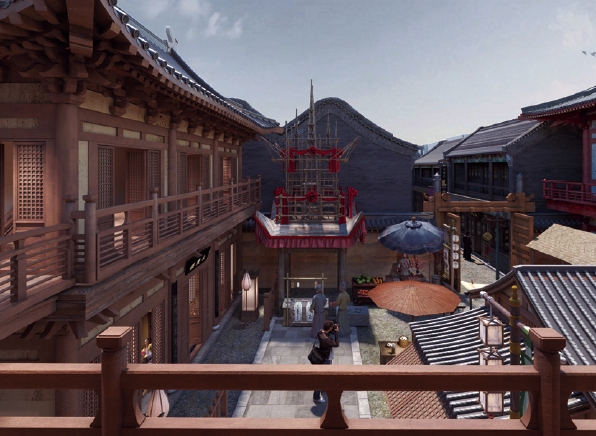
Modeled after the layout of Bianjing during the Northern Song Dynasty and based on historical sources such as the Along the River During the Qingming Festival and The Eastern Capital: A Dream of Splendor, the nightlife street scenes of the Song Dynasty are meticulously recreated. The vibrant and free trade life along the Bianhe River, following the disintegration of the Lifang (district zoning) system, is depicted through various establishments, including main shops (luxurious taverns), ornate bamboo scaffolding-like structures at entrances, and umbrella stalls offering a variety of goods.

Entrance to the gallery – The exhibition starts with the arrival of a merchant ship at the canal bank, transitioning into the bustling street scene of residential wards (fang) and markets (shi) in Luoyang.

Banquet scene
Holding banquets was very common during the Tang Dynasty, with alcohol often taking center stage and food serving as a complement. Banquets are often accompanied by female singers and dancers, and small games such as pitch-pot (a traditional Chinese game in which players throw arrows or sticks into a large canister from a set distance) and drinking games are played to liven up the atmosphere.
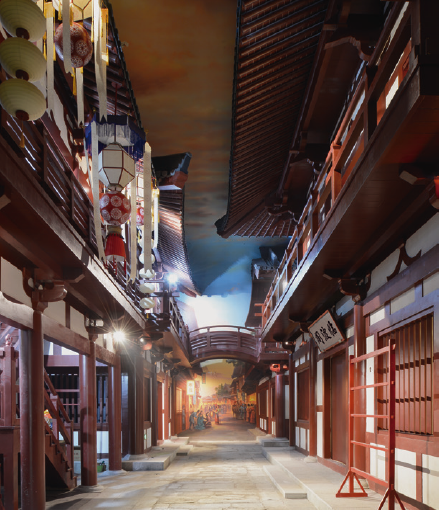
Commercial street during Sui and Tang Dynasties
During the Sui and Tang Dynasties, Luoyang City not only solidified its position as a political center but also established itself as the country’s economic and logistics hub by means of water transportation on the Grand Canal. In the well-organized city, all businesses in the residential wards and markets thrived, creating an unprecedented atmosphere of prosperity and grandeur. Important commodities such as ceramics, silk, and tea were transported here through the canal and then sold to the Western Regions (regions west of the Yumen Pass), the Korean Peninsula, Japan and other places, promoting exchanges with other countries and regions.

Commercial street during Sui and Tang Dynasties (partial view)
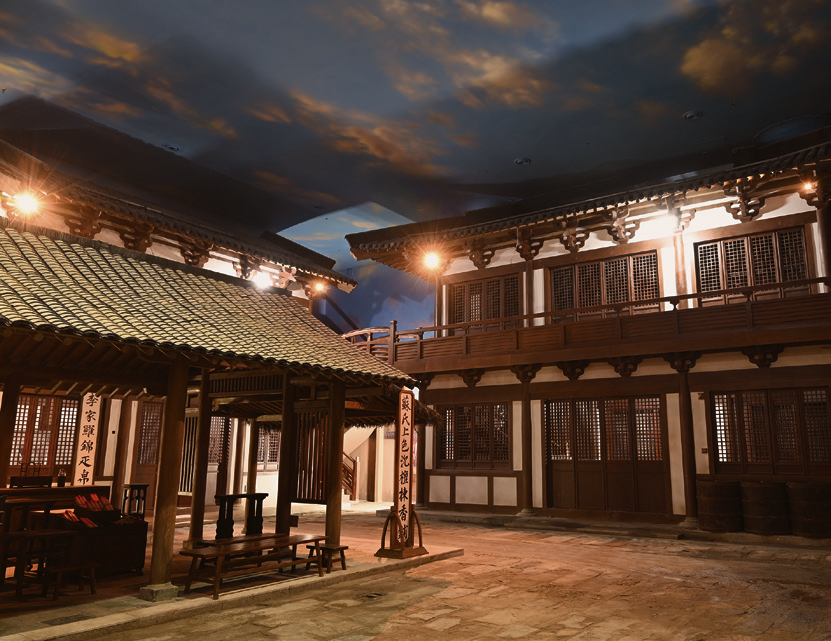
Taverns in the Song Dynasty
The alcohol culture flourished during the Northern Song Dynasty (960–1126), as evidenced by the multitude of taverns lining the streets of Bianjing. Large, luxurious taverns with brewing licenses were known as “main shops”. These establishments often used ornate bamboo scaffolding-like structures at their entrances to attract customers and drum up business.

Wutou Gate
The image of Wutou Gate first appeared in Dunhuang murals from the early Tang Dynasty. These gates were primarily used for private residences, gardens, temples, and palaces, reflecting a higher status.

Snacks in the night market
With the lifting of the curfew system, night market life in the Song Dynasty became vibrant and full of vitality. Various items were sold in the night market, with a particular abundance of snacks.
Part II Affluence in Beijing and Shandong Cities Along the Grand Canal (Area B)

Using the cities and towns in the northern section of the Beijing-Hangzhou Grand Canal as a reference prototype, this area illustrates the bustling commercial street life and the serene hutong life in the north during the Ming and Qing Dynasties.

The term “hutong” originates from the Mongolian word “gudum”, meaning water well. It refers to “a place where people gather and live”. Specifically, a hutong is a lane or alley formed by traditional courtyard compounds lining both sides. Beijing’s old hutongs are deeply integrated into various aspects of people’s lives and offer a quiet space away from the hustle and bustle of the city.

Commercial street in northern China
The bustling northern commercial street begins at an old Beijing memorial archway and is lined with traditional shops on both sides.
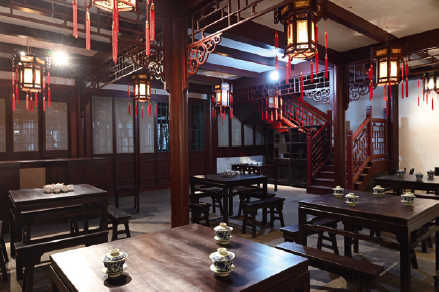
Storytelling teahouse
In the late Qing Dynasty and early Republic of China, storytelling teahouses began to appear in Beijing. These teahouses sold tea in the morning and invited artists to tell stories and perform guci songs (an art form that combines narrative lyrics, singing, and playing musical instruments such as drums) in the afternoon and evening. In a storytelling teahouse, you can experience the leisurely atmosphere of old Beijing.

Qianzhuang
Qianzhuang, also known as yinhao and piaohao, was a local independent Chinese bank that originated in the mid to late Ming Dynasty. Qianzhuang, which opened in cities and towns along the Grand Canal, witnessed the economic development and commercial prosperity that the canal brought.
Part III Grain Transport Hub and Salt Merchants at the Middle Section of the Canal (Area C)

Using the cities and towns in the middle section of the Beijing-Hangzhou Grand Canal as reference prototypes, the area showcases canal culture through commercial streets, theatrical stages, residences of salt merchants, wharves, post stations, and more, primarily in Huai’an, the canal’s grain transport hub, and Yangzhou, the center of the salt business.

Huai’an, known as the capital of the Grand Canal, is an important grain transport management city and a place where boats from the south and horses from the north of the canal meet. This area uses multimedia images and a realistic wharf scene to depict the busy water and land transportation along the Grand Canal.

Commercial street in the Huaiyang region
Thanks to the convenient transportation provided by the Grand Canal, Yangzhou developed into China’s most important center of the salt business during the Ming and Qing Dynasties. Handicrafts from the Huaiyang region (areas around the Huaihe and Yangtze Rivers, mainly Huai’an and Yangzhou) are renowned for their exquisite craftsmanship. These items were sold to cities along the Grand Canal or presented to the imperial court as tribute.
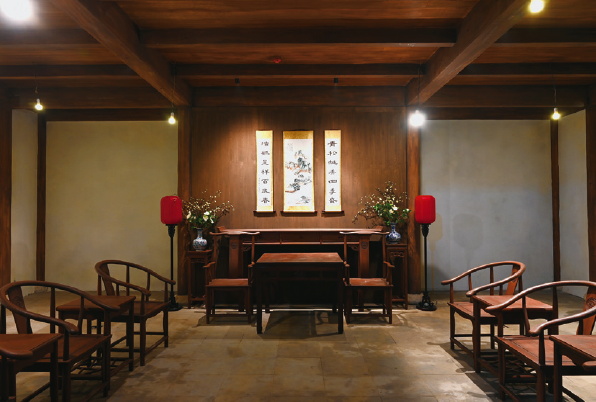
Salt merchants’ residences
Yangzhou’s prosperity, driven by the salt business and transportation, is inseparable from the efforts of salt merchants. Salt merchants in Yangzhou were intellectuals who enjoyed abundant wealth and led refined and luxurious lifestyles. Their residences showcase the highly commercial civilization and exquisite architectural skills fostered by the salt economy.
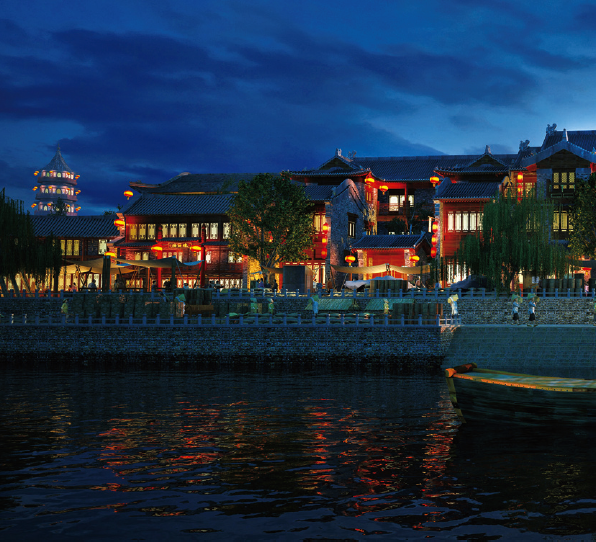



Background video of “travelling south by boat and north by horse”
During the Qing Dynasty, only grain boats were allowed to pass through the canal north of Qingjiangpu (now the main urban area of Huai’an City). Passengers and goods were transferred to carriages, horses or boats at this point, traveling north by land or south by water. Therefore, Huai’an controlled the vital thoroughfare between southern and northern China and was known as a “transfer point for traveling south by boat and north by horse and great location accessible to many places”.
Part IV Street Life in Water Towns South of Yangtze River (Area D)

This area draws inspiration from cities and towns near the Eastern Zhejiang Canal in the southern section of the Beijing-Hangzhou Grand Canal, with a particular focus on those located south of the Yangtze River (Jiangnan) along the canal. Picturesque Jiangnan water towns are showcased by a blend of water and land transportation, long waterfront verandas, small bridges arching over flowing streams, and charming riverside houses.

Waterfront veranda
Waterside verandas in Jiangnan are two stories high and connected in a row. The long corridor on the ground floor provides convenient shelter on rainy days and can also be used for rest.

Water town in Jiangnan
Densely covered with water networks, cities in Jiangnan supports both land and water transportation. You can take a boat ride along the canal system and enter a city through a water gate. Small bridges, flowing streams, and riverside dwellings along the way showcase the typical features of a water town.

Tianhou Palace
The stone-carved gate of the Tianhou Palace (literally means “Palace of the Empress of Heaven”) or Qing’an Guildhall in Ningbo City, Zhejiang Province, serves as the exit of the gallery and marks the end of the commercial streets.


Riverside houses
As the saying goes, “boats are moored outside every house”. Riverside houses are a unique type of residence in Jiangnan water towns. There are steps leading to a wharf by the water, providing easy access for boats and making it convenient for daily water use.

A long parade of red trousseaux
“A long parade of red trousseaux” is a wedding custom that has been popular in the Ningshao area (northeast of Zhejiang Province) since the Southern Song Dynasty. The custom involves a wide variety of items that encompass all aspects of daily life.









